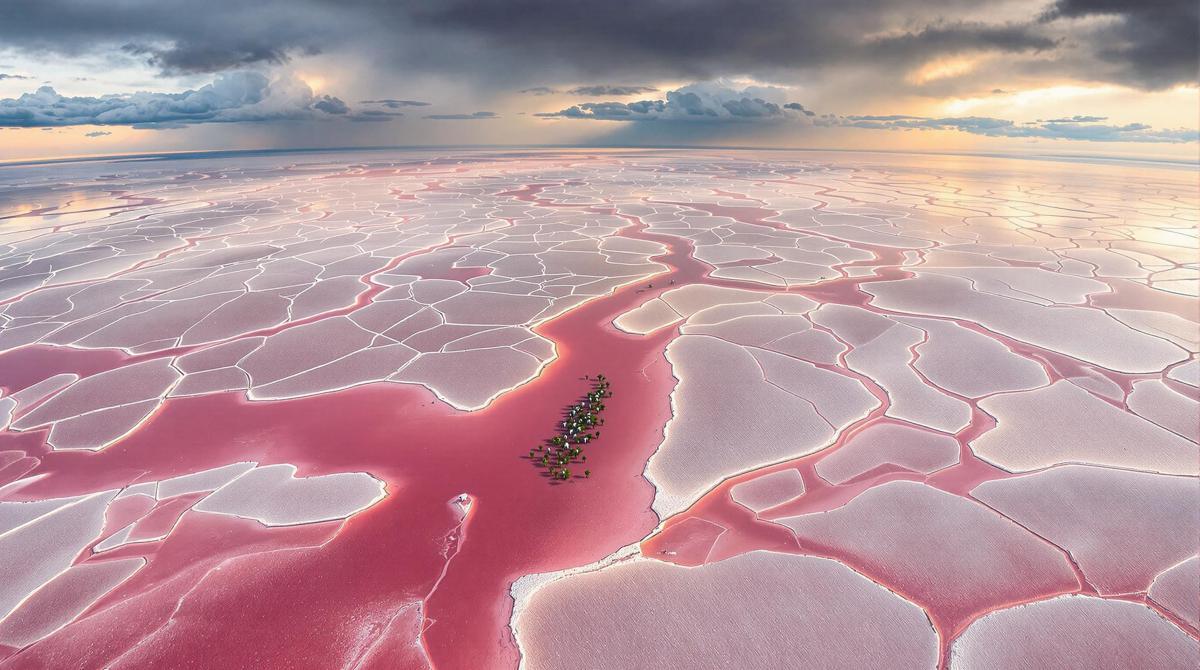Kati Thanda-Lake Eyre: Australia’s Otherworldly Desert Sea
A desert that transforms into an inland sea
In the heart of South Australia’s outback lies a natural wonder that defies imagination – Lake Eyre. This massive salt flat, officially named Kati Thanda-Lake Eyre, sits 15 meters below sea level, making it Australia’s lowest point. But what makes this destination truly remarkable is its dramatic transformation. Once every decade, this barren salt pan floods to become Australia’s largest lake, creating a desert miracle that draws travelers from across the globe.
“When Lake Eyre fills, it’s like watching the desert come alive. The whole landscape transforms before your eyes – it’s Australia’s greatest natural magic trick,” explains aboriginal elder Robert Coulthard, whose ancestors have witnessed these cycles for thousands of years.
The pink phenomenon that photographers chase
During certain flooding events, Lake Eyre develops a stunning pink hue caused by the beta-carotene produced by algae in the water. This otherworldly transformation creates one of Australia’s most photographed natural phenomena. The contrast between the crimson waters and the stark white salt crystals creates a landscape that seems more alien than earthly, drawing photographers willing to brave the remote conditions for the perfect shot.
A bird-watcher’s paradise in the desert
When water flows into Lake Eyre, an astonishing ecological event unfolds. Waterbirds arrive by the thousands, somehow sensing the lake’s transformation from hundreds of miles away. Pelicans, banded stilts, and silver gulls create massive breeding colonies, transforming this seemingly lifeless landscape into a bustling avian metropolis. For bird enthusiasts, these rare flooding events rival some of the most spectacular wildlife gatherings on earth.
The experience is similar to the manatee gatherings at Crystal River in Florida, though in a dramatically different setting.
Scenic flights: The ultimate Lake Eyre experience
While ground access is possible via 4WD vehicles, the true majesty of Lake Eyre can only be fully appreciated from above. Scenic flights from the outback towns of William Creek or Marree offer breathtaking views of the lake’s vast expanse. From this vantage point, travelers witness the intricate patterns formed by salt crystals and water channels that resemble abstract art painted across the earth.
Aboriginal dreamtime stories
For the Arabana people, traditional custodians of this land, Kati Thanda is a place of profound spiritual significance. Their dreamtime stories tell of how the lake was formed by the Rainbow Serpent as it traveled through the desert. These ancient narratives connect today’s visitors to a cultural heritage dating back tens of thousands of years, adding rich cultural depth to the stunning visual experience.
The unexpected wildlife of a salt lake
Surprisingly, Lake Eyre hosts life even during dry periods. The salt-resistant Lake Eyre dragon, a small lizard specially adapted to this harsh environment, scurries across the salt crust. After rains, dormant crustaceans emerge from the mud, their eggs having waited years for the right conditions. This resilient ecosystem rivals even the strange adaptations found in Socotra’s alien landscapes.
A geological wonder millions of years in the making
Lake Eyre sits at the lowest point of a massive internal drainage system covering one-sixth of Australia. Formed over millions of years, this basin collects water from distant Queensland catchments, sometimes traveling over 1,000 kilometers before reaching the lake. The geological forces that created this vast depression have shaped one of Australia’s most unique and magnificent landscapes.
“It’s a landscape that makes you feel small,” shares outback pilot Tom Barnes, who’s flown thousands of visitors over the lake. “The vastness stretches beyond what your eyes can comprehend – it’s humbling in the purest sense.”
The striking volcanic landscapes nearby
The area surrounding Lake Eyre features striking volcanic formations that complement the lake’s otherworldly feel. Though less dramatic than California’s volcanic wilderness areas, these ancient mounds and cones add another dimension to the outback exploration experience.
Planning your visit: Timing is everything
Visiting Lake Eyre requires careful planning. The lake’s flooding is unpredictable, though most likely to occur between March and June following heavy rains in Queensland. The harsh summer temperatures make winter (June-August) the ideal time to visit. Travelers should book accommodations in nearby towns like Marree or William Creek well in advance, as options are limited in this remote region.
For adventurous souls seeking retirement destinations with natural beauty, Lake Eyre offers a striking contrast to places like Malta’s sunshine paradise.
A prehistoric art gallery in the desert
The Lake Eyre region contains significant Aboriginal rock art sites, though not as extensive as those found in Africa’s ancient wilderness areas. These sacred locations provide fascinating insights into how indigenous people thrived in this challenging landscape for tens of thousands of years.
Lake Eyre represents Australia at its most extreme and beautiful – a place where the harshest desert conditions produce one of nature’s most spectacular transformations. For travelers seeking landscapes that challenge their perception of Earth, this vast salt pan promises an experience that lingers in memory long after the outback dust has been washed away.
